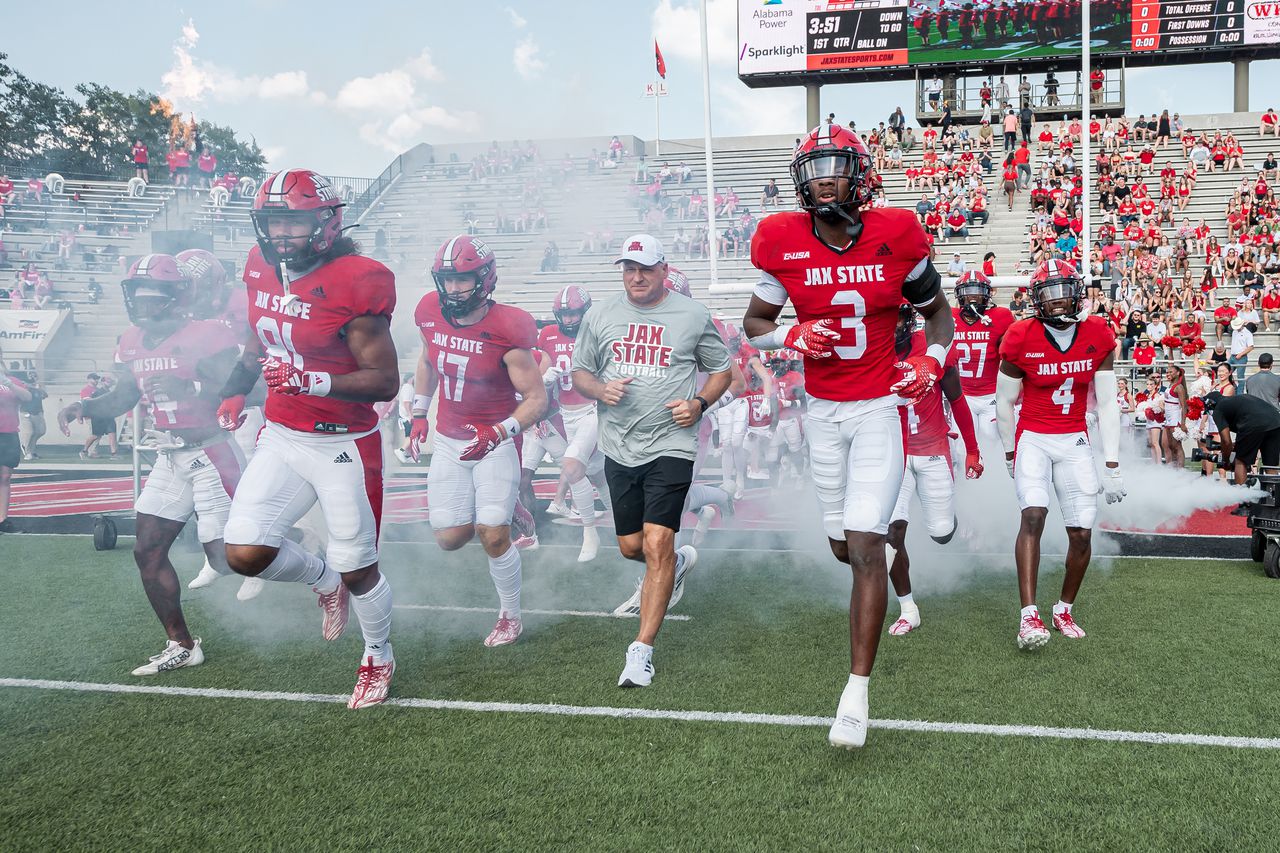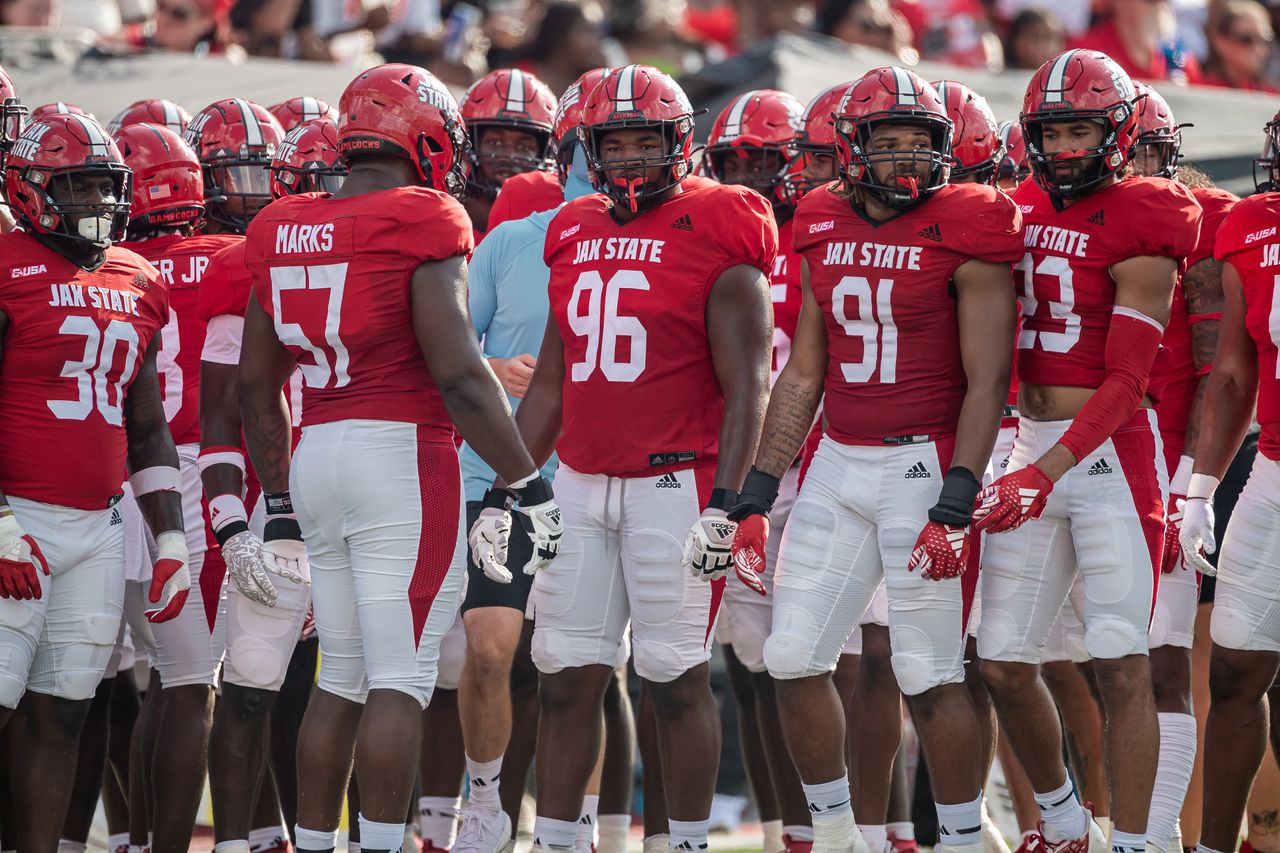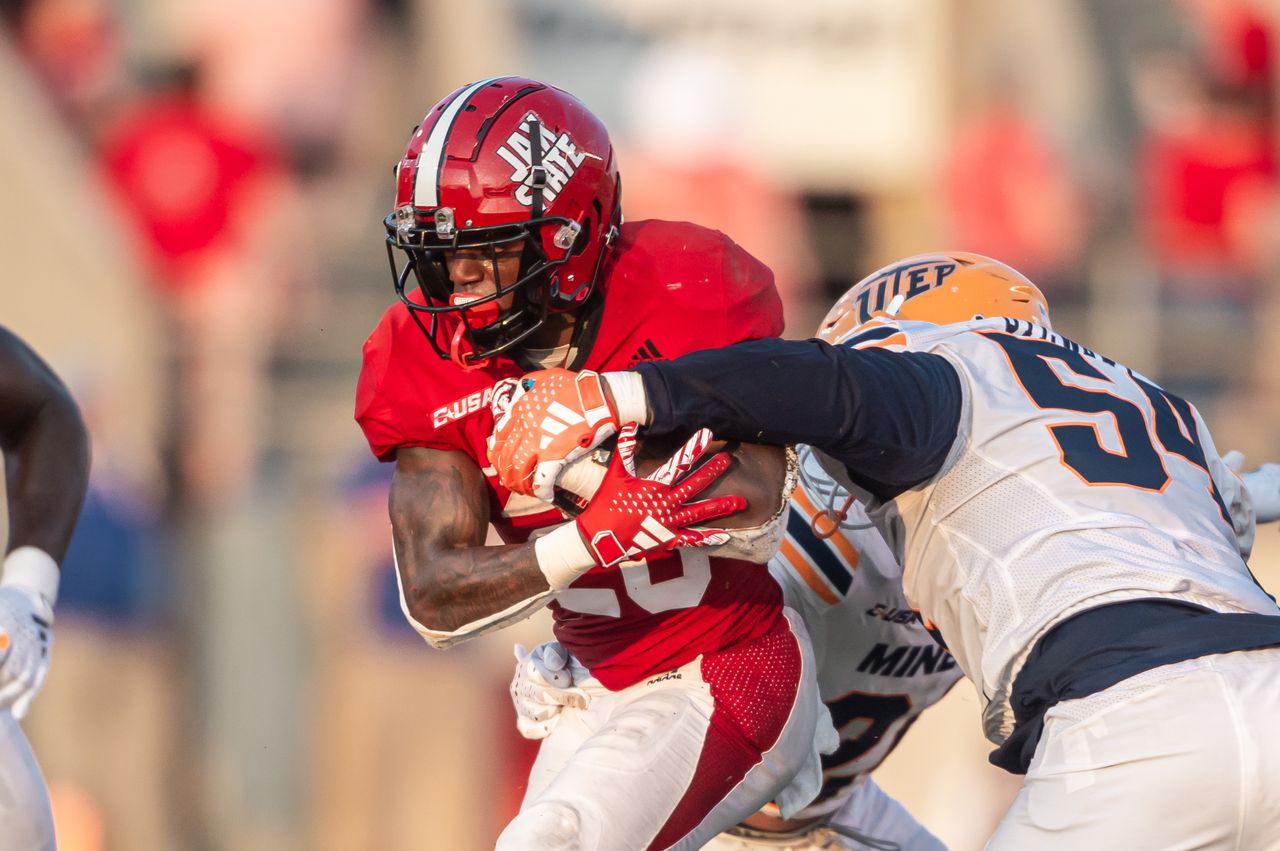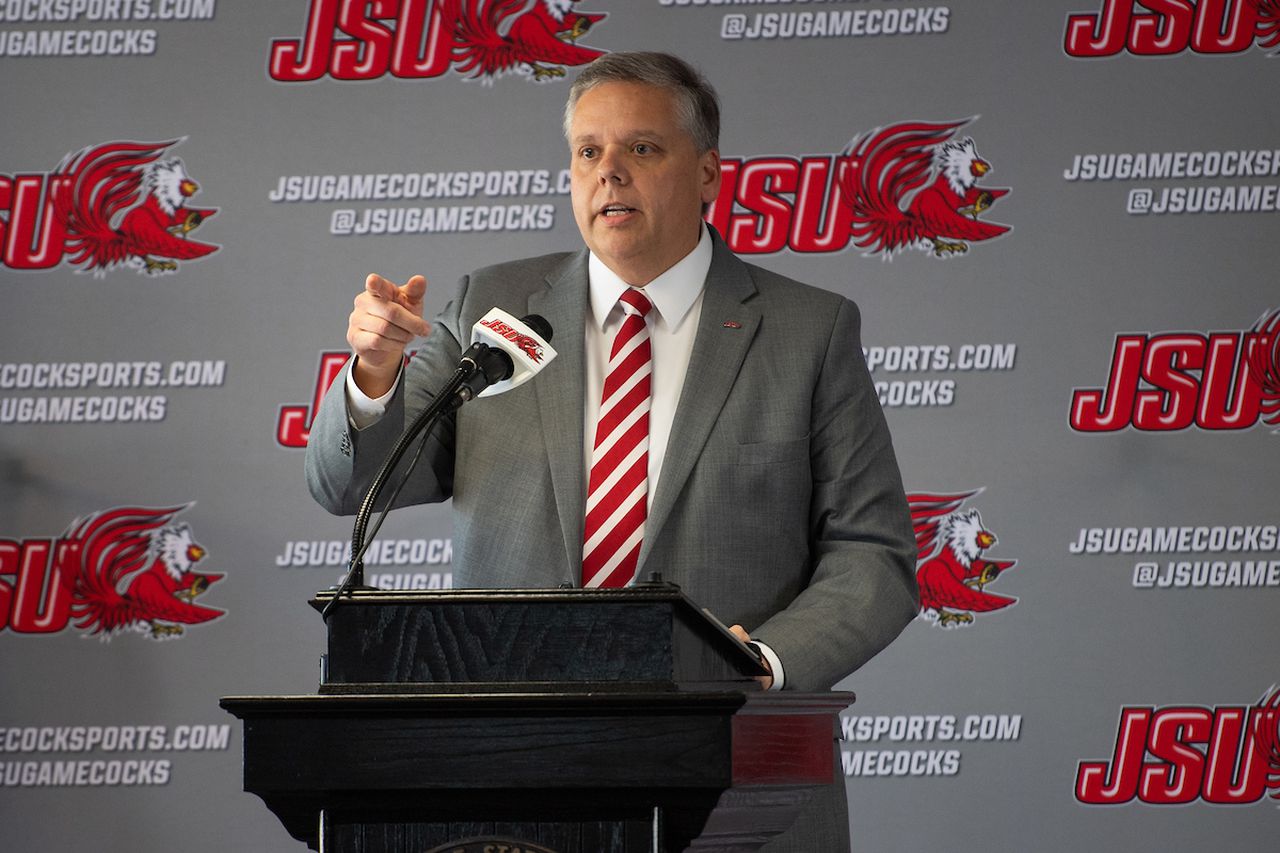Jax Stateâs âbig moveâ to FBS a long time in the making
Jacksonville State’s first game as a FBS program went so well, it was almost as if it was scripted.
And in a way it was.
The Gamecocks beat new Conference USA rival UTEP 17-14 at Burgess Snow Stadium last Saturday, getting a late interception from cornerback Jeremiah Harris to secure the victory. It was a day more than a century in the making, the culmination of years of upwardly mobile effort for a program that played its first football game in 1903.
“It’s truly unbelievable; I kind of have to pinch myself,” athletics director Greg Seitz said shortly after the victory over UTEP. “… When you look at the progression pf Jacksonville State, the investment we’ve made in our athletic facilities over the last 10 years and the competitive success we’ve had, we were ready to make the move.
“… I’m so proud of where we are and just tonight, to be part of the first-ever Conference USA win, first FBS win, I mean, I’m one happy camper. It’s great. And all the hard work that has gone into this move, on a night like tonight, it was all worth it.”
Seitz joined the Jax State athletics department as assistant sports information director shortly after graduating from the University of North Alabama in 1993, just as the Gamecocks were transitioning from Division II to Division I. JSU had been a powerhouse in D2, winning a national championship in 1992 under coach Bill Burgess and playing for it three other times with Burgess or Jim Fuller at the helm.
Jax State joined the Southland Conference before moving over to the Ohio Valley and finally the A-SUN. The Gamecocks were a highly competitive football program at the Division I-AA/FCS level under coaches Jack Crowe, Bill Clark and John Grass, qualifying for the playoffs 10 times and reaching the national championship game in 2015.
But a seismic shift at the FBS level opened up a spot for the Gamecocks to move up once again. After Texas and Oklahoma jumped from the Big 12 to the SEC in 2021, the Big 12 raided the American Athletic Conference, and the AAC in turn pillaged Conference USA.
CUSA was left with just five member schools after all the movement and acted quickly to invite FCS schools Jax State and Sam Houston along with FBS independents Liberty and New Mexico State. Kennesaw State will transition from FCS in 2024 to make it a 10-team league.
The timing turned out to be perfect for JSU, from both a financial and competitive standpoint. Rich Rodriguez, who won nearly 120 games in stops at West Virginia, Michigan and Arizona, came on board as head coach just in time for the move up.
“I got that call from Conference USA in October of 2021,” said Seitz, who became JSU’s AD in 2016. “They came and made an on-campus visit on Tuesday, invited us Wednesday, we worked through legal (considerations) Thursday, we made the announcement on Friday. So when I say this thing went fast, I mean, it went really fast.”
Jacksonville State athletics director Greg Seitz is shown in 2021. The Gamecocks’ AD since 2016, Seitz has worked in the JSU athletic department for 30 years. (JSU athletics photo)
There were several reasons Jax State felt like it had to act as quickly as it did, Seitz said. First, there was an NCAA constitutional convention scheduled for Nov. 15, 2021, and there was concern the entire structure of FBS football might be revamped (that turned out not to be true, but there was no way of knowing that at the time).
In addition, Jacksonville State was able to move up to FBS for a fee of just $5,000. Beginning with the 2023-24 cycle, that fee rises to $5 million (Kennesaw State will be the last school to make the move for the lower fee, Seitz said).
Moving to the FBS level meant Jax State had to find financing for an addition 22 scholarship in football (FCS programs carry just 63 players on scholarship, as opposed to 85 in FBS play). The Gamecocks elected to do so over a two-year period, rather than all at once.
“I spoke with the folks at App State, with Georgia Southern, with other schools that had made the move, and I said, ‘Hey, after you went through the transition, looking back on it, what do you what do you think you would have done different or wish you could have done different?’” Seitz said. “And the biggest thing we learned out of that was, go ahead and increase your scholarships. So last year, we had 75 scholarships. Then, in February, we were at the full 85. So we got a head start on it.
“Our university has certainly committed to the move, and our Board of Trustees are so supportive. We couldn’t have done this move without our Board of Trustees and the athletic committee. All of our trustees are just so supportive from that aspect of it. … To be at the FBS level, you’ve got to have a minimum of 210 (scholarship athletes) and spend $6 million on scholarships. And so we were already doing both of those things.”
The day after Jacksonville State announced it was joining Conference USA, Grass stepped down after eight seasons as head football coach. He had led the Gamecocks to six conference championships, but there were questions as to whether he was the man who could take JSU football to the next level.

Jacksonville State head coach Rich Rodriguez takes the field with his team before a game vs. UTEP at Burgess-Snow Stadium in Jacksonville last Saturday. (Brandon Phillips/Jacksonville State athletics)
Rodriguez — who famously turned down the Alabama job in 2007 just before Nick Saban was hired — had been fired at Arizona in 2017 following accusations of sexual harassment and creating a hostile work environment, before resurfacing as offensive coordinator at Ole Miss and later at Louisiana-Monroe (Rodriguez denied the allegations at Arizona, though he did admit to having an extramarital affair). He was the level of coach who might not be available under normal circumstances, and that Jax State felt it could and should take a gamble on.
“We were fortunate to be able to land Rich Rodriguez as our football coach,” Seitz said. “Obviously, he’s a guy that could have been head coach at the University of Alabama several years ago. For him to be coaching for us at Jacksonville State, it was name-brand recognition. He’s won a lot of games at a lot of places, and gave us instant credibility. I think it also showed Jacksonville State is serious about this move to FBS.”
Rodriguez succeeded immediately at JSU, going 9-2 in his first season and finishing in first place in the A-SUN. (The Gamecocks were not eligible to win the conference championship or participate in the FCS playoffs because they were transitioning to FBS. They are also not eligible for the CUSA title in 2023 and cannot play in a bowl game unless there are not enough 6-win teams to fill all the postseason slots.)
Though the opening victory against UTEP was certainly a fantastic way to start, Rodriguez is not so naïve as to think there won’t be setbacks. He said he realizes building a successful FBS program is a long process.
“We’ve got so much to prove,” Rodriguez said. “To sit here and say we we’re an established FBS program, we’re not there. We’ve got to get bigger, faster, stronger. But the wheels are in motion, not just in the football program, but in the athletic department, what we’re doing with the school facilities. Most teams it takes a few years, three to four years of transition, to get to a bowl game, to have success. None of us around here are that patient, but I’m not saying it’s going to happen right now, this year. But I think our process is a little ahead, hopefully a little ahead of schedule.”
As Rodriguez noted, JSU is in the midst of a $90 million facilities upgrade, which includes a new football operations building attached to the west end zone at Burgess-Snow Stadium. The old press box on the north end of the stadium will be torn down and replaced with additional luxury suites, dropping the stadium’s capacity slightly, from 24,000 to around 22,000.
Jax State has also upgraded its baseball, basketball and tennis facilities in the last decade or so, and is building new dormitories and a new on-campus dining hall. Seitz said the money flowing in from current and future broadcast contracts will help offset those costs, and will more than justify making the move to FBS.
“In the coming years, the television money is going to continue to grow,” Seitz said. “A lot of folks don’t realize that in the NCAA budget, 97% comes from the men’s basketball tournament, the CBS/Turner package. That funds all of Division I, all of Division II, all of Division III. There are 371 basketball schools in Division I, but we’re No. 133 in football at the FBS level. From the College Football Playoff money, the leagues each get $10 million. So for us, it’s a $1 million payout. And when the contracts are re-worked in a couple of years, it’s going to go up. There’s no doubt that the SEC and those schools will certainly take a large chunk of that, but there will still be plenty of trickle-down money for the rest of us.”

Jacksonville State players get set to take the field for a game vs. UTEP at Burgess-Snow Stadium in Jacksonville last Saturday. (Brandon Phillips/Jacksonville State athletics)
Jax State is now the sixth FBS program in the state, joining Alabama, Auburn, UAB, Troy and South Alabama. Only five states — Texas, Ohio, California, Florida and North Carolina — have more major-college programs, and all of them have populations more than twice Alabama’s 5.07 million according to 2022 U.S. Census Bureau estimates.
Said another way, Alabama has one FBS team for roughly every 874,000 people. Compare that to Florida, with seven FBS programs but 22 million people, or one team for every 3.1 million potential fans.
So it’s fair to ask if we’ve reached a saturation point for FBS football in Alabama. Probably not, said Victor Matheson, a professor of economics at the College of Holy Cross in Massachusetts and a widely respected expert on the business of sports.
“The big thing here is that most schools making the leap from FCS to FBS, it’s not that big a leap,” Matheson said. “They’re not going to wildly increase their number of spectators and the sort of things that you that that would lead to saturation. So you might say, there’s not room in Alabama for six teams, each drawing 80,000 fans every Saturday. That’s probably true. But schools like Jacksonville State aren’t making that kind of move.
“You take a school like Liberty in Virginia, which recently moved up to FBS. When they were in FCS they were drawing around 16,000 fans a game. In FBS, they’re drawing about the same. Some schools, such as Coastal Carolina, have seem a bump in attendance in Year 1, but it tailed off right away after the novelty wore off a little bit. So I don’t think moving up is going to mean a whole lot of additional attendance (at Jax State), which means that we’re probably not going to be any more saturated than we were before.”
One other thing Alabama has going for it is the lack of professional sports, which Texas, Ohio, California, Florida, North Carolina — not to mention several other states with fewer FBS teams than Alabama — all have. Thus, adding one more FBS team to the mix isn’t likely to have a large effect on the overall interest level within the state, Matheson said.
However, one aspect that will change with the move for Jax State is television exposure. In the past, the Gamecocks could expect to be on national television only when they were playing a Power 5 conference program on the road or if they reached the FCS playoff semifinals or national championship game.
JSU’s opener with UTEP was broadcast via CBS Sports Network, and five other games this season are already scheduled for national broadcasts. Four of those are being played on Tuesday, Wednesday or Thursday in late September or early October, as part of CUSA’s contract with ESPN, a trend of which Matheson said he’s not a fan.
“I think (those midweek games) are selling out both the student experience and the athlete experience for a little bit of TV money,” Matheson said. “Now, you’re getting more exposure on those nights, because there is just so much other football on TV on Saturdays. But again, playing on Tuesday or Wednesday is probably worse for the student-athletes. They miss a lot of class, for not a whole lot of payoff for the guys who aren’t going pro. And then the students themselves, it lessens the in-person experience in exchange for a little bit of TV real estate. And I don’t know if that’s necessarily a good tradeoff.”

Jacksonville State running back Ron Wiggins (26) carries the ball vs. UTEP at Burgess-Snow Stadium in Jacksonville last Saturday. Wiggins, a Jacksonville native, scored the Gamecocks’ first touchdown as an FBS program as part of a 17-14 victory. (Brandon Phillips/Jacksonville State athletics)
Then there are the players themselves, 85 more of which are now playing FBS football in the state of Alabama than just a couple of years ago. Those players have to come from somewhere, and Jacksonville State will be competing with UAB, Troy and South Alabama for many of them.
The institution of the NCAA transfer portal a few years ago and the adoption of the one-time transfer waiver in 2021 has been the great equalizer in that regard, however. Tyler Siskey, an Alabama native who has worked on football staffs at Alabama, Ole Miss, Arkansas State, Troy and South Alabama, said there are more than enough players to go around.
“There are usually 75 to 85 Division I-caliber players in the state of Alabama every year,” said Siskey, who co-hosts the “Siskey and McCready” college football podcast and operates QwikU, a database for football recruiting prospect information and video content. “But the No. 1 reason that there’s plenty of players in the state is the transfer portal. Fewer and fewer high school kids are getting signed these days because schools would rather recruit (more experienced players) out of the portal. No one is signing 25 high school kids every year anymore. Some players that are FBS-quality are having to sign at the FCS level. So yeah, there’s plenty of kids.”
And even though Jax State, UAB, South Alabama and Troy all occupy the same state, they might not necessarily recruit the same territory. Most schools use the rule-of-thumb that they are going to focus on those players from within a half-day’s car ride from their campus, which isn’t the same radius for every school in Alabama.
For example, South Alabama focuses primarily on the corridor from New Orleans to the Florida Panhandle when searching for out-of-state talent. Jacksonville State has traditionally recruited the north half of the state of Alabama, while also dipping into Tennessee and the Atlanta area, one of the country’s football hotbeds.
“We want to be able to cover the state of Alabama,” Rodriguez said. “And certainly, we’re close to Atlanta and other areas in Georgia. We don’t turn anybody down from anywhere, but we know there are a lot of talented players within a couple hundred miles of our school. I have some experienced coaches that have recruited in a lot of different areas, and we want to be able to recruit nationally, although we’re still going to be more locally-based. The bottom line is, once they come here and visit and see our place, they’ll see what we see about how unique and how exciting it’s going to be coming here in the future.”
Seitz certainly isn’t worried that the move won’t be a success for the Gamecocks, not with more than 100 years of football tradition (including what is purportedly the country’s largest marching band) and an enthusiastic and dedicated Board of Trustees that includes music legend Randy Owen of the band Alabama and Randy Jones, who owns insurance agencies all over the state. Only Alabama and Auburn within the state have a more passionate following than do the Gamecocks, Seitz said.
So with all those pieces in place, all that’s left is for Jax State to continue winning on the field. It was perhaps fitting that JSU’s first FBS touchdown was scored by junior running back Ron Wiggins, a hometown kid who played high school ball three miles away from Burgess-Snow Stadium at Jacksonville High School.
“Just being from here and coming to the games when I was younger and now years later, we’re now FBS, national televised games, more exposure, it’s a big thing,” Wiggins said. “I’m happy for where this program is going.”
Creg Stephenson has worked for AL.com since 2010 and has written about college football for a variety of publications since 1994. Contact him at [email protected] or follow him on Twitter at @CregStephenson.
